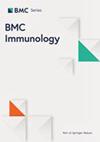CD39 可识别肺腺癌相关转移性胸腔积液中的特异性 CD8 + T 细胞群
IF 2.9
4区 医学
Q3 IMMUNOLOGY
引用次数: 0
摘要
恶性胸腔积液(MPE)是一种复杂的微环境,包含众多免疫和肿瘤信号,在肺癌中很常见。基因改变,如驱动基因突变,被认为会影响非小细胞肺癌微环境(TIME)中的肿瘤免疫成分。在这项研究中,我们发现与新确诊的表皮生长因子受体突变型(EGFRmu)肺腺癌(LUAD)相比,野生型表皮生长因子受体(EGFRwt)肺腺癌(LUAD)胸膜 CD39 + CD8 + T 细胞选择性升高。此外,这些 CD39 + CD8 + T 细胞在表皮生长因子受体酪氨酸激酶抑制剂(AR-EGFR-TKIs)获得性耐药的 MPE 中更为普遍。我们的分析表明,胸膜 CD39 + CD8 + T 细胞表现出衰竭表型,但仍具有细胞溶解功能。此外,与 CD39-CD8 + T 细胞相比,它们具有更高的 T 细胞受体 (TCR) 复合物克隆性,这是 LUAD 相关 MPE 的一个独特特征。进一步的研究表明,在使用AR-EGFR-TKIs的MPE胸膜CD39 + CD8 + T细胞中,TCR-Vβ克隆性往往更强。总之,我们在 MPE 中发现了表达 CD39 的 CD8 + T 细胞亚群,它们可能是肿瘤反应性 CD8 + T 细胞。这项研究为了解 EGFRmu 肿瘤微环境的动态免疫组成提供了新的视角。本文章由计算机程序翻译,如有差异,请以英文原文为准。
CD39 identifies a specific CD8 + T cell population in lung adenocarcinoma-related metastatic pleural effusion
Malignant pleural effusion (MPE), which is a complex microenvironment that contains numerous immune and tumour signals, is common in lung cancer. Gene alterations, such as driver gene mutations, are believed to affect the components of tumour immunity in the microenvironment (TIME) of non-small-cell lung cancer. In this study, we have shown that pleural CD39 + CD8 + T cells are selectively elevated in lung adenocarcinoma (LUAD) with wild-type epidermal growth factor receptor (EGFRwt) compared to those with newly diagnosed mutant EGFR (EGFRmu). Furthermore, these CD39 + CD8 + T cells are more prevalent in MPE with acquired resistance to EGFR-tyrosine kinase inhibitors (AR-EGFR-TKIs). Our analysis reveals that pleural CD39 + CD8 + T cells exhibit an exhausted phenotype while still retaining cytolytic function. Additionally, they have a higher T cell receptor (TCR) repertoire clonality compared to CD39-CD8 + T cells, which is a unique characteristic of LUAD-related MPE. Further investigation has shown that TCR-Vβ clonality tends to be more enhanced in pleural CD39 + CD8 + T cells from MPE with AR-EGFR-TKIs. In summary, we have identified a subset of CD8 + T cells expressing CD39 in MPE, which may potentially be tumour-reactive CD8 + T cells. This study provides new insights into the dynamic immune composition of the EGFRmu tumour microenvironment.
求助全文
通过发布文献求助,成功后即可免费获取论文全文。
去求助
来源期刊

BMC Immunology
医学-免疫学
CiteScore
5.50
自引率
0.00%
发文量
54
审稿时长
1 months
期刊介绍:
BMC Immunology is an open access journal publishing original peer-reviewed research articles in molecular, cellular, tissue-level, organismal, functional, and developmental aspects of the immune system as well as clinical studies and animal models of human diseases.
 求助内容:
求助内容: 应助结果提醒方式:
应助结果提醒方式:


